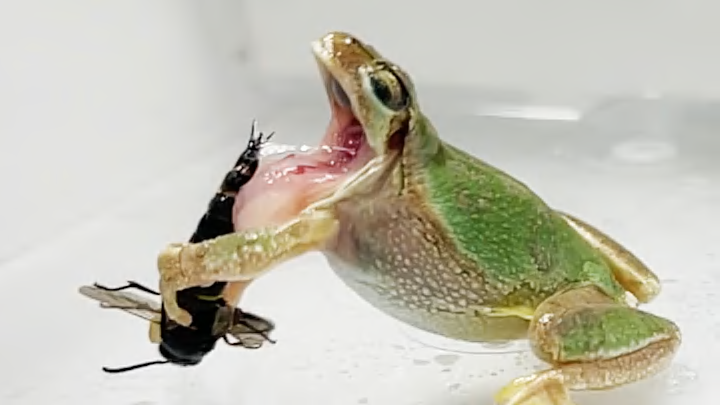There are few things worse in nature than snacking on a wasp and discovering they have the ability to defend themselves with genital spikes. Yet that appears to be the fate of some tree frogs, according to new research.
A paper recently published in the journal Current Biology demonstrates that certain species of male wasps come equipped with a pokey apparatus on their genitals meant to mimic stinging ability, which only females have due to their ovipositors, or egg-laying organs. When a larger animal—like a frog—attempts to ingest the male wasp, the prey can surprise the predator with a non-venomous jab. The defensive strategy may prompt the frog to spit out the wasp unharmed.
Researchers at Kobe University in Japan put male mason wasps (Anterhynchium gibbifronsin) in a container with tree frogs, forcing a confrontation. All 17 frogs tried to eat their prey, and two-thirds of them were successful. One third of the wasps, however, eluded their fate with their spikes. Wasps that had their genitals removed, however, were eaten 100 percent of the time.
You can see the David Cronenberg-esque scene below:
While the genital stabbers boost the wasps’ odds of survival, it’s not quite the same as having the venom to back it up: Female wasps managed to escape roughly 87 percent of the time.
The study suggests that the male wasps are able to emulate an anti-predator defense somewhat successfully. “Of course he can’t sting, but he’s trying to fake you out,” sting expert Dr. Justin O. Schmidt, who was not involved in the study, told The New York Times. “So you look at it and say, ‘Oh, wow, this is a female, bad news.’ I think it’s a form of startle as much as an absolute defense.”
While this kind of multi-use genitalia can increase their ability to escape, the identity of the wasp’s predator is still a factor. Against pond frogs, all the males were devoured.
[h/t Smithsonian]
